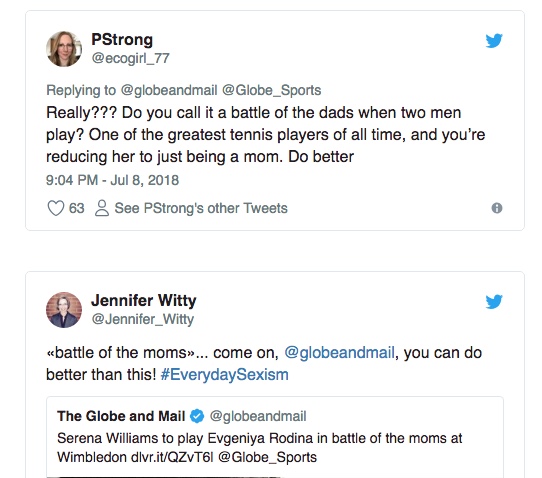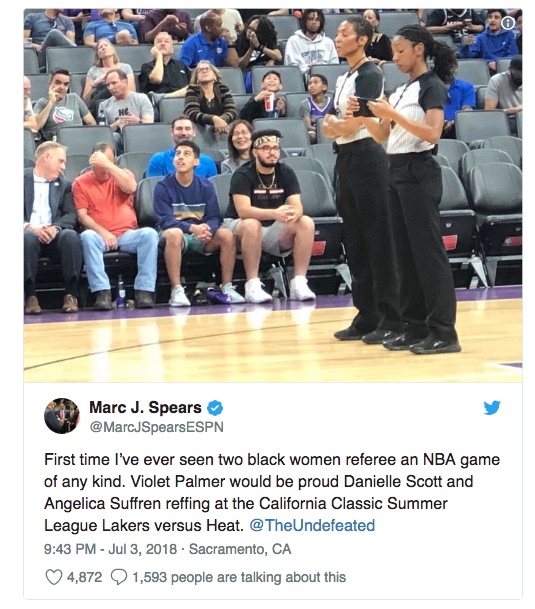From Wimbledon to the Charles River: Girls, Women, Tennis, NBA, and Crew
/Photo from the Underwood Archives
How Empowering Girls to Confront Conflict and Buck Perfection Helps Their Well-Being
Girls, more than boys, are socialized to feel the pressure to please people in their lives, to seek perfection, and to do what they can to avoid conflict, which means they don't learn, as boys do, how to "fight" back in ways that can lead them to constructive outcomes. Here's a story by KQED's Mindshift that presents parents and educators with ways to help young girls to "engage in productive conflict, acknowledge and grow from mistakes, develop emotional intelligence and take responsibility for the role they each play in social situations." By the age of six, girls are less likely than boys to identify their own gender as being "really, really smart."
Marriage and Motherhood at Wimbledon
From The New York Times, July 4, 2018
First marriage:
If Serena Williams wins Wimbledon this week, she'll be a married woman champion. That means her name as champion will switch from Miss S. Williams, which is what it's been, to Mrs. A. Williams, though she neither goes by Mrs. nor is Williams her husband's surname (Alexis Ohanian), which are the only two ways that would befit putting a Mrs. in front of it. Tradition dictates, however, that this is how her name would be recorded, just as it was for Chrissy Evert (Mrs. J.M. Lloyd) and Billie Jean King (Mrs. L.W. King). Fortunately, the club has a compendium that logs the marital history of every woman who has reached the semifinals or finals, except for Martina Navartilova who married a female spouse.
“If you don’t know who Mrs. R. Cawley is, you can consult a glossary in the Wimbledon Compendium, an exhaustive record of the tournament’s history. Compiled by the Wimbledon librarian, the compendium also logs the marriage history — husband, wedding date and location — of any woman who has reached the semifinals or final. No such record is kept for the men who have graced the tournament’s final four. Nor does the book appear to include any same-sex marriages, like the nine-time singles champion Martina Navratilova’s 2014 union to Julia Lemigova.”
Now motherhood:
It was nearly 30 years after Evonne Goolagong won the Wimbledon singles in 1980 that another mother, Kim Clijsters, became a Grand Slam champion. She won the 2009 United States Open, the first of three Grand Slam titles that she collected after the birth of her first child. This year six mothers were in the Wimbledon draw, compared with 20 players who are fathers. Now Serena and other moms are speaking out about having nurseries at tournament sites.
“‘When I was younger, I was thinking by the age of 27 I would be so tired of tennis that I wouldn’t want to do it,’ said Vera Zvonareva, who is now 33 years old. ‘That was the first thought. The second thought was if I have a family, then for sure my career is over.’
Williams and Azarenka, two of Wimbledon’s newer moms, have clout, and no reservations about exercising it. Azarenka, 28, a member of the WTA Player Council, has championed giving top players returning from their maternity leaves seeding consideration at tournaments.
Wimbledon broke with the status quo by granting the 183rd-ranked Williams the No. 25 seeding here, and the United States Open last month announced it would revise its approach to seeding players coming back from pregnancy.”
Serena Williams has shared with the public her postpartum depression and what it took to fight herself back into world-class competitive shape. Then, this week from Wimbledon she tweeted about crying when she heard her daughter took her first steps and she wasn't there to see her.
Moms throughout the world empathized with her feelings and tweeted her back with stories of baby and toddler milestones they'd missed, too.
Then, there's the issue of how the media treats motherhood in the context of tournament coverage. When it happened that two moms played each other The Globe and Mail’s headline read: “Serena Williams to play Evgeniya Rodina in battle of the moms at Wimbledon," to which many tweeters replied as these two did:
Huff Post: ‘Battle Of The Moms’ Headline For Serena Williams-Evgeniya Rodina Game Causes Uproar
Finally, the Ball Girls
It was in 1977 that Wimbledon first invited girls to try out to be ball girls. Here's how UPI reported this news:
“The All‐England Lawn Tennis and Croquet Club at Wimbledon bowed to the women’s liberation movement today and said It would permit ballgirls for the first time at this summer’s annual tennis tournament. The club has agreed to employ 10 girls from schools in the Wimbledon area to help the 70 boys it will hire for the championships. The girls will wear the same purple and green shirts as the boys, but with skirts instead of shorts. The club board’s decision resulted from a campaign by girls at Pelham High School and supported by their games’ supervisor, Liz Kelly.”
Not until three years later did Wimbledon mix ball boys and girls on a team (1980), and five years would pass again before ball girls appeared on Centre Court for the first time.
Wimbledon website
How ballgirls and ballboys are selected today for Wimbledon.
Gender and Referees:
How two black women referees expanded the conversation about representation in sports
Referees have been left out of the conversation
Lots of eyes turned toward Danielle Scott and Angelica Suffren, two black women referees, when they showed up at an NBA Summer League game between the Los Angeles Lakers and the Miami Heat. It's the first year that the NBA recruited women to officiate at their training ground program like the NBPA Top 100 Camp. In 2017, a third of the referees in its minor league basketball program were women.
Building a pipeline?
Closer to Home: From Rower to Cox
Gained new appreciation for coxswains who more often than not are women given our lighter weight. In my case, me being cox was not about lesser weight but only because I volunteered to take on this role for a 1,000 meter race on Sunday morning on the Charles River. There is a lot of multitasking involved – the cox is motivator-in-chief, primary steerer, stroke rate watcher, and the person in charge of 8 rowers whose adrenaline kicks in. It's the cox's job to focus them on setting a powerful, sustainable rhythm that means catching together to start each stroke, pushing back with power from their feet/legs, and never losing focus in the competition of a sprint race. Here's photos taken of us during the race and on the dock upon our return:
The Cronwell Cup, July 8, 2018, Charles River
Back home at the CRI dock, Cronwell Cup 8









